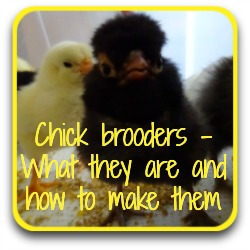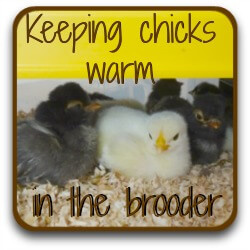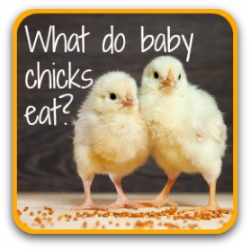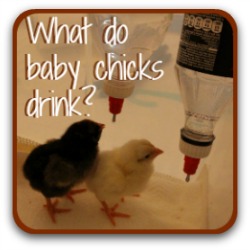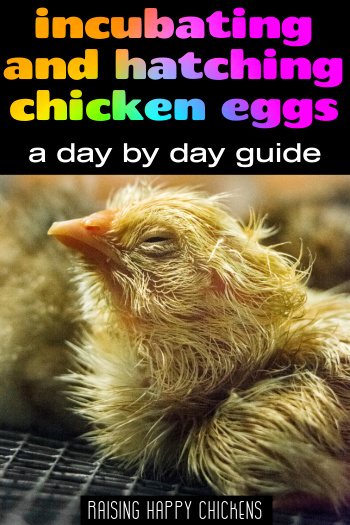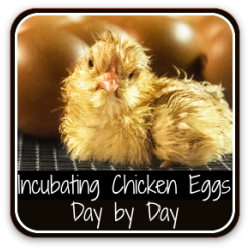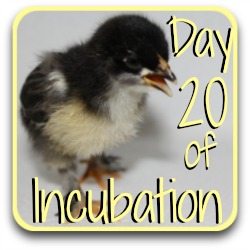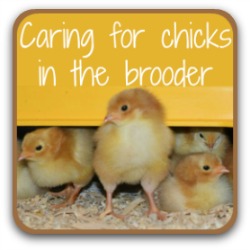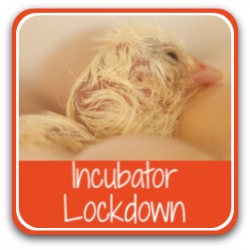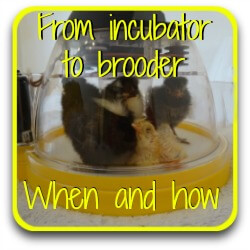- Home
- Incubation day by day
- Day 21
Hatching day for chicken eggs: day 21 of incubation.
It's here - you've done it: it's hatching day!
All the hard work for the past 20 days of incubation is about to pay off as our eggs begin to hatch.
But a word of warning: hatching day for chicken eggs is not always Day 21.
It happens on average today, but if your eggs are showing no signs of pipping yet please, do not worry. In my hatches it's been quite common for eggs to hatch at day 24, and I've had one hatch as late as day 26.
It's tempting, but don't sit for hours obssessing over the incubator. Make sure instead that you are well prepared for those chicks when they do make an appearance.
This is a very long article. Use these links to jump to a section you need help with – or continue to read.

What's going on in the egg today?
- The yolk sac, together with its blood supply, should now be fully absorbed into the chick and will provide nourishment for the first critical hours after hatching.
- The 'umbilicus' or belly button closes over. When the chick has hatched you might see the stalk still attached. It looks like a dark piece of cotton and it will drop off within a couple of days.
- Now the chick is filling the egg and is ready to hatch.
Hatching day for chicken eggs: what's happening to the chick?
- Between Days 20 and 21 the chick's neck begins to spasm and it 'pips' or breaks through the internal membrane, taking its first breath from the air cell.
- This is a critical point in terms of humidity. If the air is too dry, the membrane will literally harden and shrink round the chick. As a result, it will not be able to hatch.
- Humidity should be held at 65%. As hatch gets closer, and once chicks begin to hatch, it will rise naturally. Raising the incubator lid will lower humidity and should be done with great care.
Please note: the image below is a commissioned piece and is subject to international copyright laws. I am the sole copyright owner.
It must not be used, copied or reproduced anywhere without my permission.
Contact me for details and permissions for this and all other images on this page.
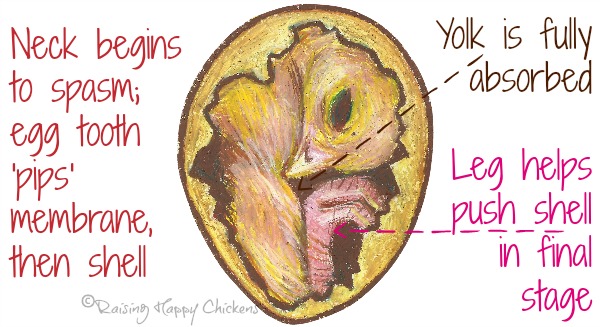
- Within the next few hours the chick will need more oxygen than the air cell can provide. It will use the egg tooth to break through the shell's outer membrane, and then the shell itself.
- This is called "pipping", and it's the first sign we'll be able to see that the process of hatching has begun.
Chicken egg hatching stages.
1. When do chicks start pipping?
- The first "pip" – a small crack in the egg's surface – generally shows at day 21, but can be much later.
- By this stage, the chick will have broken through the inner membrane and taken its first breath. Now it needs more oxygen and knows instinctively it must break through the shell.
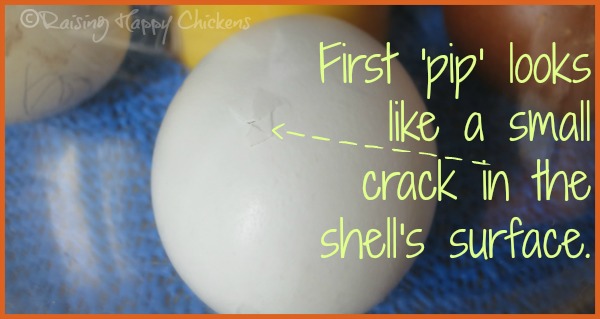
- From first pip to hatch does not happen immediately. Incubation has been a peaceful process, but hatching is tiring and the chick needs to rest.
- Some will hatch very quickly but I've had a chick pip and show no further signs of development at all for 21 hours.
- As long as the chick has this small breathing hole, and given that you're keeping humidity levels raised to around 65%, it really doesn't matter that it's not gone any further straight away.
Don't worry and above all, don't be tempted to "help" at this point.
2. Stages of hatching day for chicken eggs: from pip to unzip.
- The next stage is commonly called "unzipping".
- The chick uses its wing as a guide and its legs to propel turning.
- With the hard, pointed egg tooth it pecks through the shell in a roughly circular motion until almost the whole of the blunt end of the shell has been pecked through.
- The photographs that follow are all of one of my Wyandotte eggs. It took 25 hours from first pip to hatch. She is now a healthy, happy adult hen.
- Notice the increased humidity on the walls of my Brinsea incubator as we go through the hatching process.
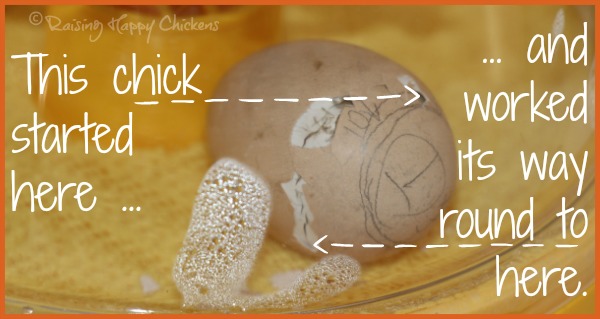
At this point the chick's legs take on a lot of the work. They push the two halves of the shell apart.
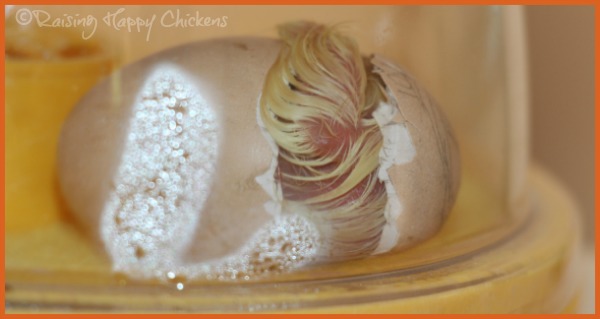
3. Chicken egg hatching...
Finally, the chick is finally able to push and pull its way free of the shell.
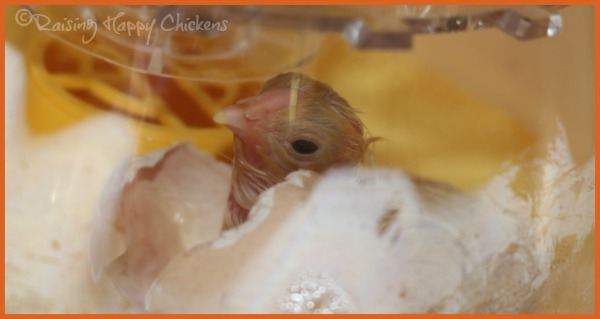
Hatching day for chicken eggs: what happens now?
The newly hatched chick will very quickly find its feet and stumble around the incubator. It will bump into, lie on top of and climb over other eggs and newly hatched chicks.
When I first experienced this I wanted to "save" the other eggs by moving those who had hatched.
But the cheeping and bumping of new chicks is thought to act as a motivation for the unhatched chicks to start pipping.
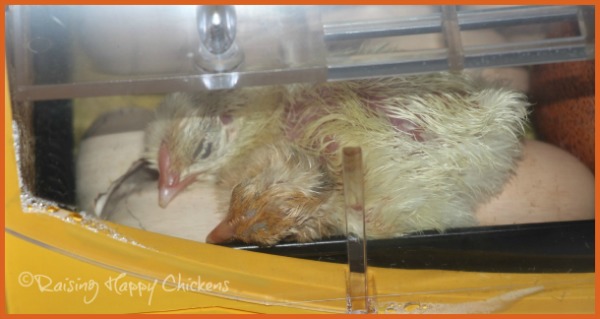
Leave the chicks in the incubator until it's dried out and fluffed up. Be careful here: chicks can chill very easily and you should not move them too soon.
When is it safe to move the chicks to their brooder?
They should be completely dried out and fluffy before they leave the incubator.
Sometimes it's difficult for them to dry out, particularly if other chicks are hatching and humidity is very high.
I have a separate incubator which I keep to put newly-hatched chicks in if they're having a hard time fluffing up. I bought it after having lost a chick who had hatched successfully but who couldn't dry properly and was chilled.
I was devastated. Despite it costing money I vowed never to be in that position again, so I bought a second Brinsea Mini Advance – my favourite of all incubators.
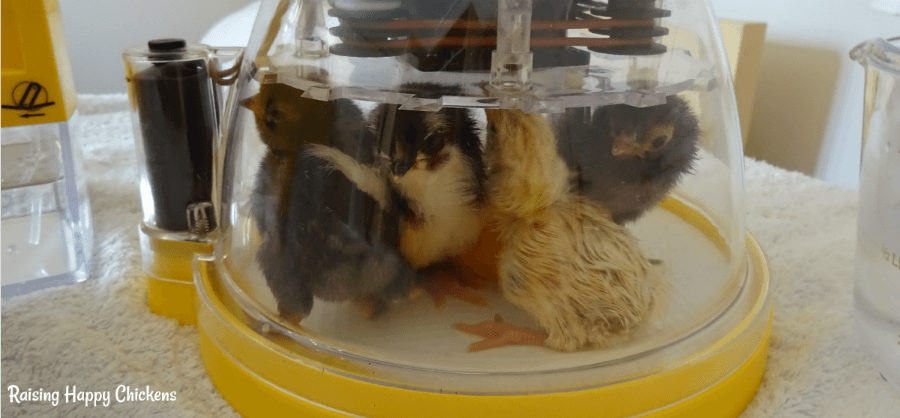
Be careful not to open the lid of the incubator to remove chicks unless you're positive no other chicks have started to pip.
Here is more information about moving chicks from incubator to brooder.
Hatching day for chicken eggs: what else should we be doing today?
Encourage chicks to pip.
As this process begins, you may be able to hear sounds of the chick 'peeping' before you see even a tiny hole in the shell. In natural circumstances the mother hen will cluck to or peck on her eggs to encourage them to hatch, and the chick will cheep back.
Have I ever tried to be a 'mother hen' and cluck to my eggs? Absolutely!
Try tapping on the side of your incubator, and listen for the peeps coming back!
Prepare for those chicks!
On days 18 and 19, we looked at preparing for chicks by making sure we had a brooder ready, complete with the safest bedding; and that we had the necessary means to keep the chicks as warm as they need to be.
What do baby chicks eat?
Today, we need to make sure we have the proper food and drink for our chicks. Although they can survive for the first 24 hours (approximately) with the yolk which has been absorbed into their body, after that they will need appropriate food and drink.
See these links for more information.
Hatching day for chicken eggs: can anything go wrong at day 21?
The single thing most likely to go wrong now is to try to help the chick out of the egg. I have more e-mails from people worried that their chicks are not hatching precisely at Day 21 than on any other subject.
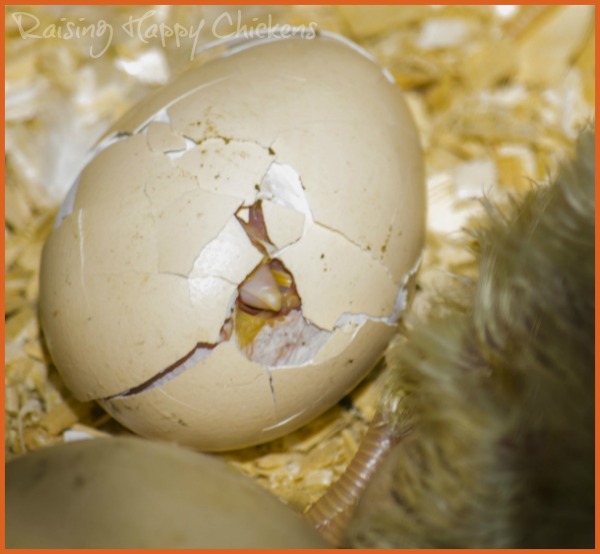
Chicks are not machines! Although the stages of incubation are the same for all eggs the time it takes to complete them is not, necessarily.
I've had chicks hatch at day 19 and others as late as day 26.
Don't be tempted to "help" your chicks out of their shells. If they're not pipping, or they've pipped but they're not unzipping, they're simply not ready.
If the yolk sac together with the blood vessels have not been fully absorbed into the stomach, the likelihood is that trying to "help" by peeling away the shell will rupture one of these blood vessels and the chick will bleed to death.
Remember: from pip to hatch can take as long as 36 hours. It's a tiring process for a little chick!
Question of the day.
When would the time be right for me to assist a chick out of the egg?
The answer to this is virtually never.
In fact some people would say categorically "never". There's a view that a chick which isn't able to hatch on its own will be too weak to survive anyway.
I don't hold to that view. I do think there's a time to help, but it's rarely as soon as you think.
To some extent this is a judgement call which comes with experience.
If the chick has pipped through the shell but there has been no further development for 12 hours or more, and the membrane looks brown rather than white, it may be possible to help.
But it needs to be done carefully and patiently.
Where would you like to go now?
If you need to go to a different stage of incubating and hatching use these links.
The first will take you back to the overview of this day-by-day course; the second goes backwards by one day to day 20; the third moves on to look at what newly hatched chicks need for the first week of life.
Other related hatching pages you may find helpful.
Sources.
A lot of "facts" you'll find on the internet are often people's individual views, based on inaccurate information repeated from poor quality sources.
The information I provide in this article and others is based on both my own experience of incubating and hatching chicken eggs every year for over 13 years, but on evidenced facts from scientific, peer-reviewed research and books from highly respected and experienced poultry keepers such as Gail Damerow.
Some of the trusted sources I have used in this article are these.
Avitronics: Heart Rates. Pub. Avian ID, 2020.
Damerow, Gail: Hatching and Brooding Your Own Chicks. Pub. Storey, 2013. See my review, here.
Hamburger, V and Hamilton, H L: A series of normal stages in the development of the chick embryo. Pub. Journal of Morphology, 1951.
Romanini, C.E.B., et al: Monitoring the hatch time of individual chicken embryos. Pub. Journal of Poultry Science, 2013.
Wu et al: Egg fertility and reduced egg fertility, hatching success, and larval survival. Pub. Science Direct, 2003.
Yalcin, W., et al: Incubation Temperature and Lighting: Effect on Embryonic Development, Post-Hatch Growth, and Adaptive Response. Pub. Frontiers in Physiology, 2022.
- Home
- Incubation day by day
- Day 21
